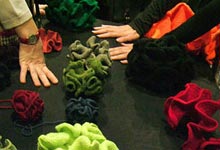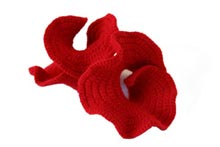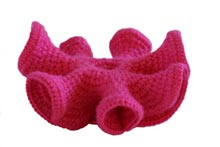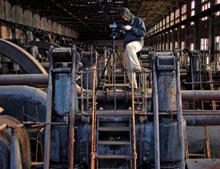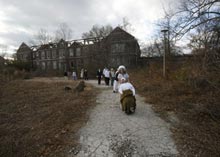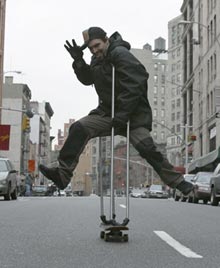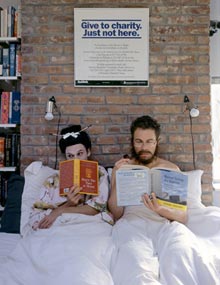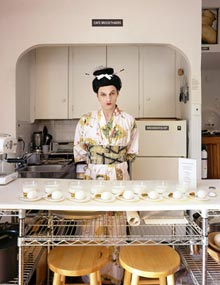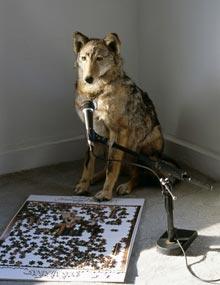Urban Test Sites
A two-weekend event series exploring radical perspectives on
space, architecture, and everyday life
June 9 -17, 2006
Grand Arts is pleased to announce Urban Test Sites, an upcoming event series spotlighting interdisciplinary and unorthodox approaches to space, architecture, and the lived experience of the city. Following the success of last year’s Mash-Up event series which brought 26 artists to Grand Arts in the span of 8 weeks, Urban Test Sites will assemble an eclectic group of artists, thinkers, and interventionists in Kansas City for a provocative two-week series of lectures, performances, and interactive events.
Presenters will draw on diverse backgrounds in mathematics, physics, dance, street performance, museum education and architectural preservation as they investigate new possibilities for Kansas City’s urban environment. The series will kick off on Friday, June 9th with a talk about hyperbolic space and its (crocheted!) models by Institute For Figuring director Margaret Wertheim. Architects, artists, crafters and knitters will want to take note of this one-of-a-kind presentation, which will touch on how hyperbolic forms might be utilized in the art and design of the future. Wertheim’s presentation will be followed on Saturday, June 10th by a city-wide scavenger hunt orchestrated by Ars Subterranea, a New York-based group of intrepid urban explorers. The following week, on Friday, June 16th, internationally-known dancer and choreographer Bill Shannon will give a multi-media presentation about his work, focusing on his roots in skateboarding culture and the site-specific, interpretive dynamics of his street performances. On Saturday, June 17th, the series will conclude with a not-to-be-missed performative walking tour by the Brooklyn-based Homeless Museum’s founder and director, Filip Noterdaeme.
All events are free and open to the public. Reservations are required for Ars Subterranea’s Kansas City Confidential scavenger hunt and Filip Noterdaeme’s HoMu Cribs walking tour. A detailed schedule of events is attached.

Friday, June 9, at Unity Temple on the Plaza, 7:30pm
Figuring Space
Lecture by Margaret Wertheim, Founder and Director, Institute For Figuring, Los Angeles
http://www.theiff.org
We have created a world of rectilinearity. The rooms we inhabit, the skyscrapers we work in, the grid-like arrangement of our streets and the freeways we cruise on our daily commute speak to us in straight lines. We have learned to play by Euclidean rules because two thousand years of geometrical training have engraved the grid in our minds. But in the nineteenth century mathematicians became aware of a space in which lines cavorted in aberrant formations, suggesting the existence of a new geometry. The hyperbolic plane, as it came to be called, revolutionized both mathematicians’ and physicists’ notions about space and revealed a world of possibility beyond rectilinear norms. In this experiential lecture, Margaret Wertheim will talk about the history and science of hyperbolic space and present a unique collection of hyperbolic models made by the craft of crochet. The event will include hands-on activity as audience members construct their own paper “soccer-ball” models of the hyperbolic plane.
Margaret Wertheim is a science writer and curator. She is the author of several books about the history of physics and is currently working on a book about “outsider scientist” James Carter and the role of imagination in theoretical physics. In Fall 2006 Wertheim is curating a show of mathematical paper foldings at Machine Project in Los Angeles and a major exhibition on the art and science of the Kindergarten system at the Williamson gallery, Art Center College of Design, in Pasadena.
The Institute For Figuring is devoted to enhancing the public understanding of figures and figuring techniques. From the physics of snowflakes and the geometry of sea slugs, to the mathematics of paper folding, the tiling patterns of Islamic mosaics and graphical models of the human mind, the Institute takes as its purview a complex ecology of figuring.
(http://www.theiff.org)

Saturday, June 10
Kansas City Confidential
City-wide scavenger hunt organized by Ars Subterranea, New York
Time and meeting place to be announced.
(http://www.creativepreservation.org)
Based on the film noir from 1952, this urban scavenger hunt will send teams of explorers into the neglected underbelly of Kansas City. Participants will use architectural clues to foil a dark conspiracy hinted at in the film, which threatens to engulf the City Beautiful. En route, the teams learn to read historic buildings for messages that will bring them closer to their goal. This game will take place on the streets of Kansas City with 52 participants, one for each card in a deck. This event requires pre-registration by e-mail to: confidential@creativepreservation.org.
Ars Subterranea is an artistic preservation group based in New York City whose goal is to bring attention to forgotten yet historically significant locations through site-specific events and other creative projects, including publishing and exhibitions. Previous projects have included an exhibition on subterranean art inside an abandoned rail tunnel, a scavenger hunt based on underground streams in New York, and a planned commemoration of a lost Paleozoic museum in Central Park, among others. (http://www.creativepreservation.org)

Friday, June 16 at Unity Temple on the Plaza, 7:30pm
Constructing the Urban Artist
Film screening and video lecture by Bill Shannon, interdisciplinary dance and media artist,
Pittsburgh/New York
(http://www.virtualprovocateur.com) (http://whatiswhat.com)
In this decade-spanning talk and screening, Bill Shannon will trace the origins of his urban street dance practice to the decaying industrial sites of Pittsburgh, circa 1980’s. From there, Shannon will lead the audience on a personal trek through desolate train yards and abandoned military sites, describing the evolution of his work and its relationship to changing urban environments. Shannon will also use personal film and video footage to trace the development of street skating and street dance forms, as influenced by music, fashion, culture and kinetics.
Bill Shannon is a conceptual dance and media artist who has received wide acclaim for his work on the stage and in the streets. He is known equally in the dance/performance world, the underground hip-hop and club dance scene, and the disabled artist community. Shannon has choreographed for Cirque du Soleil and recently exhibited his installation work at the Tate Liverpool Museum. Shannon was honored with a John Simon Guggenheim Fellowship in 2003, and has received numerous grants and awards in the United States and abroad.

Saturday, June 17
HoMu Cribs, Kansas City
Walking Tour hosted by Filip Noterdaeme, Director, Homeless Museum, Brooklyn
(http://www.homelessmuseum.org)
Time and meeting place to be announced, please contact Grand Arts to reserve a spot on the tour.
Join Grand Arts and the Homeless Museum, Brooklyn, for HoMu Cribs, an exciting way to discover the famed Homeless Museum’s art collections, displayed exclusively in select private homes. See how your neighbors transformed their cribs, entirely or partially, into cool museum dens. A walking tour will connect the various homes and invite you to celebrate the birth of a new “homeless museum” in Kansas City.
A product of New York City's cultural decline, the Homeless Museum (HoMu) is a budget-and-staff-free, unaccredited arts organization that enables and engages cultural dialogue practiced at the intersection of the arts and homelessness. Founded in 2002 by Belgian artist Filip Noterdaeme, HoMu is dedicated to exposing broad and diverse audiences to the unwanted, while simultaneously establishing and demonstrating homelessness as a significant cultural phenomenon. While the Homeless Museum and its collections offer a unique view into the conditions of homelessness, highlighting the impenetrability of a disinterested society, Noterdaeme's work as the artist behind the Museum blends absurdity with sincerity as he articulates a dual critique of the cultural institution as enterprise and the cult of the artist as shaman.
(http://www.homelessmuseum.org)
Back to top

|
|








